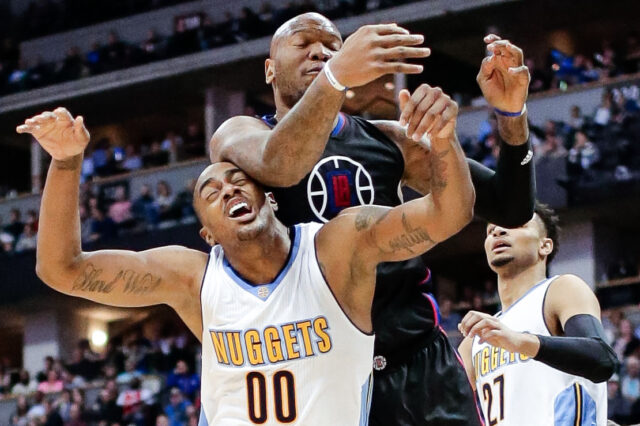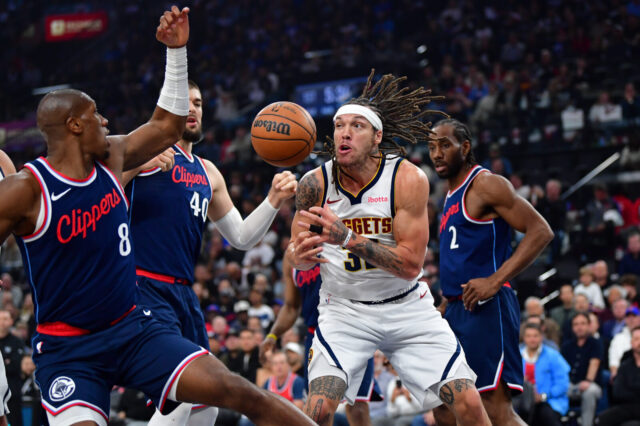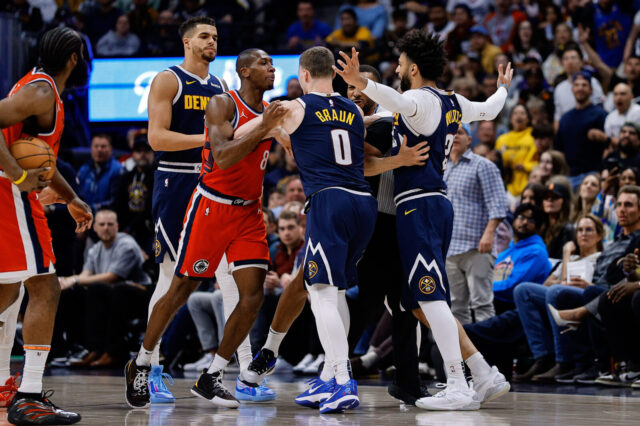How many teams possess a player 22 years old or younger that ranks among the top 3 players on their own team? How many teams can say they have two such talents in their top 3 players?
The list I have come up with on the top of my head is:
- Philadelphia 76ers (Joel Embiid and Ben Simmons or Markelle Fultz)
- Minnesota Timberwolves (Karl-Anthony Towns and Andrew Wiggins
- Denver Nuggets (Nikola Jokic and Gary Harris)
Jokic was unequivocally Denver’s best player last season, and it’s fair to say that Danilo Gallinari was second best. It’s also fair to say that Gary Harris rounds out the list, which hasn’t changed now that Paul Millsap has replaced Gallinari. Harris showed his skills last year as a cutter, a spot-up shooter, and as a terror in transition. Here are his Synergy numbers in each of those categories from last season:
This content is no longer available.
His progression and growth have been extremely encouraging for a Nuggets team that’s been desperate for a quality guard since Ty Lawson departed. So, why is it that he’s a forgotten figure among the Nuggets’ prospect hierarchy?
Among Nuggets fans, it is nearly unanimous that Jamal Murray has star potential. The former seventh overall pick in the 2016 NBA Draft showed last year that he has the ceiling of a star with his creation abilities out of the pick and roll, in isolation, and as a volume shooter from the perimeter. These points are basically inarguable. What is arguable is whether Harris could also develop as a better ball handler and creator while maintaining his excellent skills as an off-ball player.
But let’s start with the bigger picture. Harris started off his rookie season under Brian Shaw, and Shaw barely allowed Harris to see garbage time minutes. It was basically a lost season for Harris, which had many Nuggets fans concerned about the former 19th overall pick in the 2014 Draft.
When Michael Malone arrived in Denver though, he made it clear that Harris was the starting 2-guard for the Nuggets from the beginning. Harris was one of Malone’s most trusted players, even in his 21-year-old sophomore season, who made a leap in part due to this unwavering faith. This past year, Harris suffered an injury that prevented him from staying in the starting lineup until December 15th, 2016, a now fabled day in current Nuggets lore. As soon as both he and Nikola Jokic returned to the starting lineup, the Nuggets posted a 31-26 record and the 12th best winning percentage in the NBA (.544). Harris was obviously a major part of this, as his growth in both usage and efficiency helped make it possible.
After posting nearly 15 points, 3 assists, and 3 rebounds, Harris’ combination of production and efficiency put him in some interesting company among shooting guards in their third season:
- Eric Gordon
- James Harden
- Allan Houston
- Evan Fournier
- J.R. Smith
- Reggie Miller
- Byron Scott
- Michael Redd
- Sidney Moncrief
- Wesley Matthews
These ten players were the closest statistical matches I could find from both a production and efficiency standpoint as far as third seasons in the NBA go. Each player is here for different reasons and had different outcomes, but they each put together comparable numbers at around the same age or slightly older than Harris so far. Here is the chart of combined points, assists, and rebounds for each of the ten players plus Harris in their first three seasons in the NBA:
This content is no longer available.
All of these players maintained different roles and played out different paths in their future. Eric Gordon was once thought to be one of the best guard prospects in the NBA, but a trade to the New Orleans Hornets (now Pelicans) and injuries reduced his ceiling to simply an above average shooting guard. James Harden was stuck to the bench in Oklahoma City, playing as a complementary piece to Kevin Durant and Russell Westbrook for his first three seasons. He got so good in his third year that his production was only matched in the above table by players averaging 37 minutes a night or greater!
The point being, every player has their story. Gary Harris has his own story too. His rookie year was wasted by his rookie coach, but he made a massive jump in production from his first to second season (basically a guarantee), followed by an equally impressive jump from his second to third season.
The impressive part? His minute-per-game average dropped. No other player had their minutes drop from second to third season. The main reason for this drop was due to the Nuggets’ convoluted roster and Harris’ injury issues. This next year with hopefully both issues solved, there should be no reason for Harris to average less than 33 minutes a night.
Because when a player makes such a massive jump in efficiency, the smart thing to do is push them as hard as they can take it.
This content is no longer available.
That’s right. Through three seasons, Gary Harris posted the fourth highest true shooting percentage (61.1 TS%) of anyone in this group. The only ones above him? Hall-of-Famer Reggie Miller, five-time All-NBA stud Sidney Moncrief, and likely Hall-of-Famer James Harden.
The way that Harris accomplished this isn’t seen around the league as “star-like” tendencies, but because Harris is a smart basketball player. He has taken advantage of Nikola Jokic’s strengths by moving around the perimeter for open spot ups, cutting to the basket, and leaking out in transition. For both players, there is still room to grow and get better in these aspects, but their chemistry has put them in a great position to succeed thus far.
The next step for Harris is to improve his numbers while handling the basketball. Whether it be in pick and roll, hand offs, or isolations, Harris has room for improvement.
These are Harris’ overall Synergy numbers, which paint a picture of how far along Harris is already:
This content is no longer available.
That’s right, Harris ranks as good to excellent in every category except in hand offs and isolation. As a pick and roll ball handler, he was still good, but there’s room for improvement, particularly in passing situations.
In this video, the read is easy. The defender helps from one pass away, and Harris is smart enough to understand that an open corner three in rhythm is an excellent pass to make.
Where he will need to continue to improve is with this pass above. This is a more complex read because the help is coming from the weak side, and the window is much smaller to make the play. Harris was excellent at hitting the big man in the high pick and roll this year, with his passes placing him in the 93rd percentile among all players. Where he didn’t excel in was finding the spot up shooters from this location, and watching the video back, Malik Beasley becomes wide open if Harris holds the ball a split second longer under pressure.
These are reads that Harris should develop with time. In the side pick and roll, Harris is much better at making the simple read: drive to the rim, pass to the rolling big man, or pass back out to the top of the arc. His chemistry with Jokic in these plays is evident, as he is close to mastering the pocket pass that frees up the roll man so well.
This is technically a hand off, but it might as well be a side pick and roll if Harris waits half a second to use the pick set by Jokic. Still, his timing and shoddy defense combine for an easy dunk.
There are a couple of reasons why Harris’ hand off numbers are below average. One of them is his frequency, as defenses knew what he was going to do with the ball once he received it. This will improve over time as Harris learns to be more crafty. Another is that he simply may have had a down year in that department. In 2015-16, he finished in the 56th percentile on the third highest frequency in the NBA. This season? The 30th percentile on the seventh highest frequency. As Harris expands his pick and roll game, teams will have less opportunity to take away his hand offs specifically.
As for isolations, I’m not worried about Harris improving his isolation game as much. As he becomes more skilled as a ball handler in the pick and roll and in hand off situations, he will naturally become better as an isolation guy. If he’s on the floor more and given more responsibility, it will happen naturally. They are the play with the least volume and efficiency for most of the best offenses, and the Nuggets don’t need to remove Nikola Jokic and Paul Millsap from the play unless the isolation player is incredible (a la Kyrie Irving).
Back to Harris’ ceiling though. Between the two graphs, the three players that stick out to me as most comparable for Harris are Allan Houston, Byron Scott, and Michael Redd. All three guys sustained jumps in production from year one to year two, and even though Scott faltered in year three, Houston and Redd continued to climb production wise. All of them are right around Harris efficiency wise, and while each player accomplished things in their own ways, it would be fair to expect that level of production and efficiency from Harris in the future.
So what does that look like?
| Player | Peak Season | Points/gm | Assists/gm | Rebounds/gm | True Shooting % | WS/48 | WS/48 rank that season |
|---|---|---|---|---|---|---|---|
| Allan Houston | 1999-00 | 19.7 | 2.7 | 3.3 | 56.7 | .130 | 59th |
| Byron Scott | 1987-88 | 21.7 | 4.1 | 4.1 | 59.0 | .168 | 12th |
| Michael Redd | 2005-06 | 25.4 | 2.9 | 4.3 | 57.4 | .166 | 24th |
These are each of the career years from the aforementioned players, and the last column is very telling in terms of the type of player the Nuggets think Harris could be. Right now, the Nuggets and many Nuggets fans expect Harris to top out as an Allan Houston type player. Houston was good, and he topped out as a third wheel on a weak Eastern Conference Finals team in the late 1990s New York Knicks.
But what if Harris surpasses those expectations? What if his pick and roll game develops to match his already excellent perimeter shooting, cutting, and transition play? It’s not out of the realm of possibilities that he has a leap like the one made by Byron Scott or Michael Redd. Both players had excellent fourth seasons that set up solid runs for the next two to three years. The difference? Both came into the NBA earlier than Harris did, and it’s possible that Harris has even more room to grow.
Whatever the case may be, there seems to be a common thought that Harris has a lower ceiling than Jamal Murray. I think there’s an argument for that logic, and it may even be correct. There are different ways to evaluate impact though, and next to Nikola Jokic, having a player who doesn’t just excel as an off ball player, but is dominant, is a major point for Harris. Before writing him off, Nuggets fans must not only evaluate him for what he is, but for what he could be.
I expect Harris to take another leap forward this season, not necessarily efficiency wise, but in production and responsibility for the team. With Murray likely the starter at point guard, Denver will need another reliable ball handler just in case Murray succumbs to the pressure of playing point from game to game. Wilson Chandler is not that guy, and he’s the only other starter that projects as primarily a creator off the dribble. If the Nuggets don’t want to take a step back or stagnate this year, it will be because Harris takes a step forward. After averaging 15/3/3 this past season, I expect Harris to take a leap and average 16 to 17 points a game, along with 3.5 assists and 3.5 rebounds. The test will be if Harris can take a step forward in volume without losing a ton of efficiency.
And why shouldn’t he take a step or two forward? The guy is still 22 years old. The best is yet to come in Harris’ fourth season, and I have no doubt it will be a lucrative one.
This content is no longer available.


